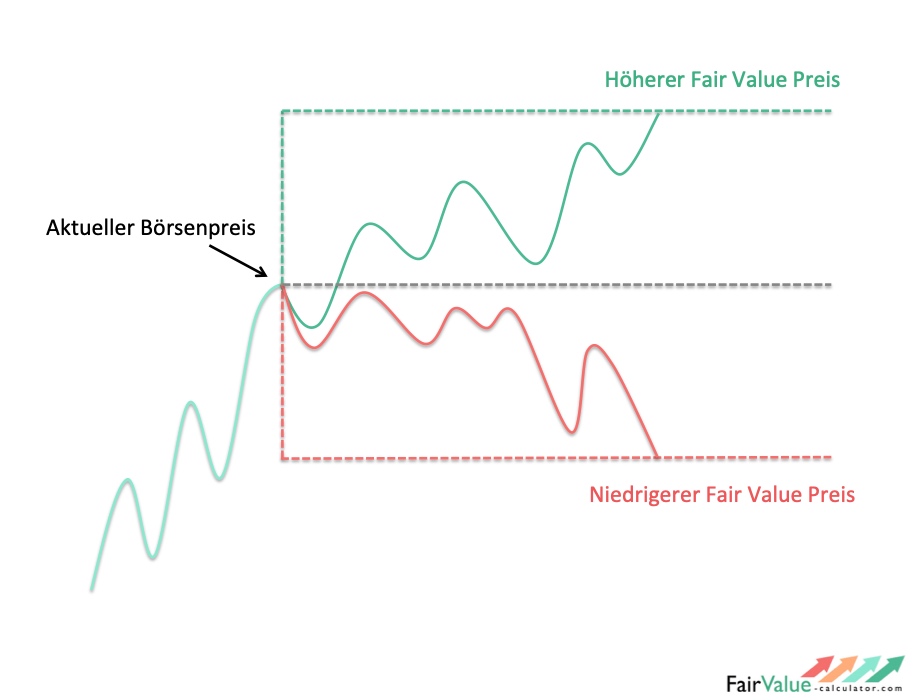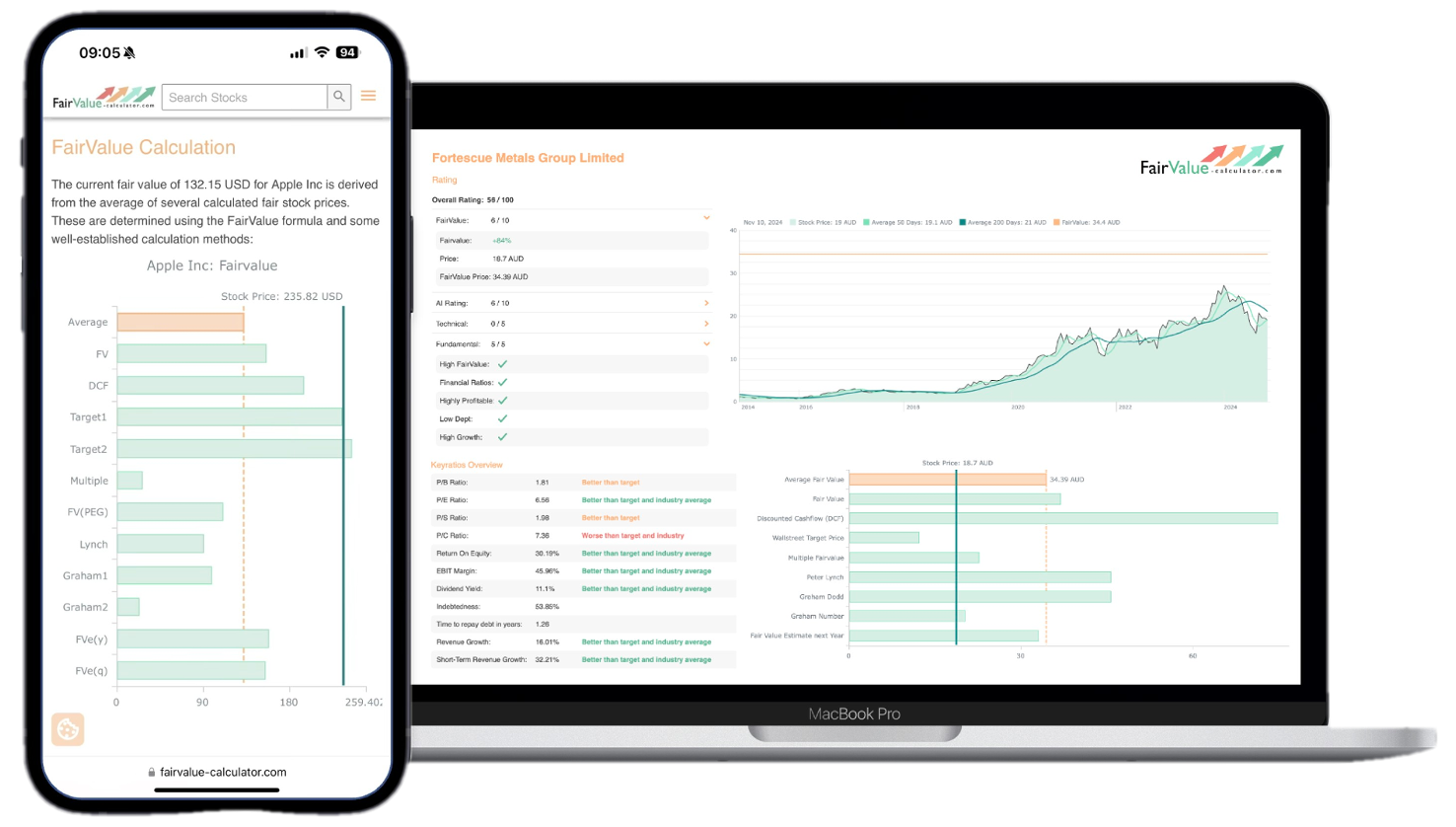Investors are always on the lookout for the fair value of undervalued companies to invest in, and the key to finding such companies lies in understanding the concept of fair value. In this article, we will explain what fair value is, how to calculate it, which financial figures are needed, where to get official financial data, which formulas are used, and what the investment strategy behind fair value is. With our Premium Tools, all data is loaded automatically, the formulas are used especially for you, and you can make informed investment decisions without having to work hard for them.
💡 Discover Powerful Investing Tools
Stop guessing – start investing with confidence. Our Fair Value Stock Calculators help you uncover hidden value in stocks using time-tested methods like Discounted Cash Flow (DCF), Benjamin Graham’s valuation principles, Peter Lynch’s PEG ratio, and our own AI-powered Super Fair Value formula. Designed for clarity, speed, and precision, these tools turn complex valuation models into simple, actionable insights – even for beginners.
Learn More About the Tools →What is Fair Value?
Fair value is the estimated value of an asset or liability, based on the current market conditions. It is the price at which an asset can be sold or liability can be settled in an open market transaction. In other words, fair value is the price that a willing buyer would pay, and a willing seller would accept in an arm’s length transaction.
🚀 Test the Fair Value Calculator Now!
Find out in seconds whether your stock is truly undervalued or overpriced – based on fundamentals and future growth.
Try it for Free →It is an important concept in the financial world, as it is used in financial reporting, auditing, and investment analysis. Financial statements such as balance sheets and income statements often provide the fair value of certain assets and liabilities.
Explore our most popular stock fair value calculators to find opportunities where the market price is lower than the true value.
- Peter Lynch Fair Value – Combines growth with valuation using the PEG ratio. A favorite among growth investors.
- Buffett Intrinsic Value Calculator – Based on Warren Buffett’s long-term DCF approach to determine business value.
- Buffett Fair Value Model – Simplified version of his logic with margin of safety baked in.
- Graham & Dodd Fair Value – Uses conservative earnings-based valuation from classic value investing theory.
- Intrinsic vs. Extrinsic Value – Learn the core difference between what a company’s really worth and what others pay.
- Intrinsic Value Calculator – A general tool to estimate the true value of a stock, based on earnings potential.
- Fama-French Model – For advanced users: Quantifies expected return using size, value and market risk.
- Discount Rate Calculator – Helps estimate the proper rate to use in any DCF-based valuation model.
How to Calculate Fair Value?
Calculating this key figure involves estimating the future cash flows that an asset or a company is expected to generate and discounting them back to their present value. This involves forecasting the expected earnings of a company and discounting them using a discount rate that reflects the risk involved in investing in the company.
To calculate fair value, you need to obtain certain financial figures for the company, including revenue, earnings, cash flow, debt, and assets. These figures can be obtained from financial statements such as the income statement, balance sheet, and cash flow statement. These statements can be found in the annual reports of public companies.
Where to Get Official Financial Data?
Official financial data can be obtained from various sources, including the company’s annual reports, SEC filings, financial websites, and financial data providers. The financial data provided by these sources can be used to calculate the fair value of a company.
Which Formulas are Used to Calculate Fair Value?
There are several formulas used to calculate the key figure we are talking about, including the discounted cash flow (DCF) method, the price-to-earnings (P/E) ratio, and the price-to-book (P/B) ratio.
The DCF method is the most commonly used formula for calculating fair value. It involves estimating the future cash flows of a company and discounting them back to their present value using a discount rate that reflects the risk involved in investing in the company.
The P/E ratio compares the price of a company’s stock to its earnings per share. A low P/E ratio indicates that a company’s stock is undervalued, while a high P/E ratio indicates that a company’s stock is overvalued.
The P/B ratio compares the price of a company’s stock to its book value per share. A low P/B ratio indicates that a company’s stock is undervalued, while a high P/B ratio indicates that a company’s stock is overvalued.
What is the Investment Strategy Behind it?
The investment strategy behind fair value involves buying stocks that are undervalued and selling stocks that are overvalued. This strategy involves looking for companies that have a lower market price than their fair value. This is because stocks that are undervalued have a higher potential for capital gains, as their price will eventually catch up with their fair value.
Investors who use the fair value strategy typically look for stocks that have a P/E ratio and P/B ratio below the industry average. They also look for stocks that have a high dividend yield, as this indicates that the company is generating enough cash flow to pay dividends to shareholders.
To sum up, calculating fair value can be a complex process that requires a significant amount of financial knowledge and time. However, with the right tools, investors can quickly and easily calculate the fair value of thousands of companies. That’s where our premium tools come in – our software automatically loads official financial data and calculates fair value for a wide range of companies. With our tools, you can save time and effort and focus on making informed investment decisions based on reliable data. Stop guessing and start investing with confidence.
FAQs
Basic Concepts
1. What exactly is fair value in simple terms? Fair value is the estimated true worth of a company or asset based on its fundamentals, representing what a knowledgeable buyer would pay and a willing seller would accept under normal market conditions.
2. How is fair value different from market price? Market price is what investors are currently paying for a stock, while fair value is what the stock is actually worth based on financial analysis. Market price can be above or below fair value due to emotions, speculation, or market inefficiencies.
3. Why should I care about fair value if I’m just a beginner investor? Fair value helps you avoid overpaying for stocks and identify potential bargains. It’s like knowing the actual value of a car before negotiating with a dealer – it prevents you from making costly mistakes.
Calculation Methods
4. Is the DCF method the only way to calculate fair value? No, there are multiple methods including DCF, P/E ratios, P/B ratios, dividend discount models, and asset-based valuations. Each method has its strengths depending on the company type and industry.
5. What discount rate should I use in DCF calculations? The discount rate typically ranges from 8-15% and should reflect the company’s risk level, cost of capital, and your required return. Riskier companies require higher discount rates.
6. How far into the future should I project cash flows? Most analysts project 5-10 years of detailed cash flows, then use a terminal value for years beyond that period.
7. What if a company has negative cash flows – can I still calculate fair value? Yes, but it’s more challenging. You might focus on revenue growth, use asset-based methods, or apply industry-specific metrics instead of traditional cash flow models.
Data and Research
8. Where can I get reliable financial data for free? SEC filings (10-K, 10-Q), company investor relations pages, Yahoo Finance, Google Finance, and FRED (Federal Reserve Economic Data) provide free access to financial statements and data.
9. How often should I update my fair value calculations? Review quarterly when companies report earnings, and recalculate annually or when significant business changes occur (new products, acquisitions, market shifts).
10. Which financial statements are most important for fair value analysis? All three are crucial: income statement (for earnings), balance sheet (for assets/debt), and cash flow statement (for actual cash generation). Each provides different insights.
Practical Application
11. What’s a good margin of safety when buying undervalued stocks? Many value investors look for stocks trading at least 20-30% below their calculated fair value to account for estimation errors and provide a buffer against losses.
12. Should I only buy stocks trading below fair value? Not necessarily. Sometimes paying fair value for a high-quality, growing company can be better than buying a declining company at a discount.
13. How do I know if my fair value calculation is accurate? Compare your results with professional analyst estimates, use multiple valuation methods, and track your predictions over time to refine your approach.
14. Can fair value analysis work for growth stocks? Yes, but it’s more challenging since growth stocks often trade at premiums to current fundamentals. Focus on future cash flow potential and use growth-adjusted metrics.
Investment Strategy
15. How long should I hold a stock after buying it below fair value? Value investing typically requires patience – months to years. Hold until the market price approaches or exceeds your fair value estimate, or until the business fundamentals change.
16. What industries are best suited for fair value investing? Mature, stable industries with predictable cash flows (utilities, consumer staples, banks) are easier to value than high-growth tech companies or cyclical businesses.
17. Should I sell immediately when a stock reaches fair value? Not necessarily. If the company continues growing and increasing its intrinsic value, the fair value target moves higher too. Consider the quality and growth prospects of the business.
Common Challenges
18. What are the biggest mistakes beginners make with fair value analysis? Being too optimistic about growth rates, using inappropriate discount rates, ignoring competitive threats, and not considering macroeconomic factors that could affect the business.
19. How do I handle market volatility when using fair value investing? View volatility as opportunity rather than risk. When quality stocks fall below fair value due to market panic, it often creates buying opportunities for patient investors.
20. What if the market never recognizes the fair value of my stock? This can happen, but historically, prices tend to converge toward intrinsic value over time. Ensure your analysis is sound and consider whether something fundamental has changed about the business.
Advanced Considerations
21. How do interest rate changes affect fair value calculations? Rising interest rates typically lower fair values (higher discount rates reduce present value of future cash flows), while falling rates can increase fair values.
22. Should I adjust fair value for inflation? Yes, consider inflation’s impact on future cash flows and use real (inflation-adjusted) discount rates when appropriate, especially for long-term projections.
23. How do I value companies with significant intangible assets? Traditional book value becomes less relevant. Focus on cash-generating ability, competitive moats, brand value, and intellectual property’s contribution to future earnings.
24. Can fair value analysis work in all market conditions? Fair value analysis works best in normal to bear markets when emotions drive prices away from fundamentals. In extreme bull markets, even “overvalued” stocks may continue rising due to speculation.







